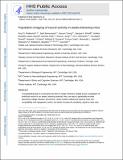Notice
This is not the latest version of this item. The latest version can be found at:https://dspace.mit.edu/handle/1721.1/138167.2
Population imaging of neural activity in awake behaving mice
| dc.contributor.author | Piatkevich, Kiryl D | |
| dc.contributor.author | Bensussen, Seth | |
| dc.contributor.author | Tseng, Hua-an | |
| dc.contributor.author | Shroff, Sanaya N | |
| dc.contributor.author | Lopez-Huerta, Violeta Gisselle | |
| dc.contributor.author | Park, Demian | |
| dc.contributor.author | Jung, Erica E | |
| dc.contributor.author | Shemesh, Or A | |
| dc.contributor.author | Straub, Christoph | |
| dc.contributor.author | Gritton, Howard J | |
| dc.contributor.author | Romano, Michael F | |
| dc.contributor.author | Costa, Emma | |
| dc.contributor.author | Sabatini, Bernardo L | |
| dc.contributor.author | Fu, Zhanyan | |
| dc.contributor.author | Boyden, Edward S | |
| dc.contributor.author | Han, Xue | |
| dc.date.accessioned | 2021-11-19T16:29:36Z | |
| dc.date.available | 2021-11-19T16:29:36Z | |
| dc.date.issued | 2019 | |
| dc.identifier.uri | https://hdl.handle.net/1721.1/138167 | |
| dc.description.abstract | © 2019, The Author(s), under exclusive licence to Springer Nature Limited. A longstanding goal in neuroscience has been to image membrane voltage across a population of individual neurons in an awake, behaving mammal. Here we describe a genetically encoded fluorescent voltage indicator, SomArchon, which exhibits millisecond response times and is compatible with optogenetic control, and which increases the sensitivity, signal-to-noise ratio, and number of neurons observable several-fold over previously published fully genetically encoded reagents1–8. Under conventional one-photon microscopy, SomArchon enables the routine population analysis of around 13 neurons at once, in multiple brain regions (cortex, hippocampus, and striatum) of head-fixed, awake, behaving mice. Using SomArchon, we detected both positive and negative responses of striatal neurons during movement, as previously reported by electrophysiology but not easily detected using modern calcium imaging techniques9–11, highlighting the power of voltage imaging to reveal bidirectional modulation. We also examined how spikes relate to the subthreshold theta oscillations of individual hippocampal neurons, with SomArchon showing that the spikes of individual neurons are more phase-locked to their own subthreshold theta oscillations than to local field potential theta oscillations. Thus, SomArchon reports both spikes and subthreshold voltage dynamics in awake, behaving mice. | en_US |
| dc.language.iso | en | |
| dc.publisher | Springer Science and Business Media LLC | en_US |
| dc.relation.isversionof | 10.1038/S41586-019-1641-1 | en_US |
| dc.rights | Article is made available in accordance with the publisher's policy and may be subject to US copyright law. Please refer to the publisher's site for terms of use. | en_US |
| dc.source | PMC | en_US |
| dc.title | Population imaging of neural activity in awake behaving mice | en_US |
| dc.type | Article | en_US |
| dc.identifier.citation | Piatkevich, Kiryl D, Bensussen, Seth, Tseng, Hua-an, Shroff, Sanaya N, Lopez-Huerta, Violeta Gisselle et al. 2019. "Population imaging of neural activity in awake behaving mice." Nature, 574 (7778). | |
| dc.relation.journal | Nature | en_US |
| dc.eprint.version | Author's final manuscript | en_US |
| dc.type.uri | http://purl.org/eprint/type/JournalArticle | en_US |
| eprint.status | http://purl.org/eprint/status/PeerReviewed | en_US |
| dc.date.updated | 2021-11-19T16:21:45Z | |
| dspace.orderedauthors | Piatkevich, KD; Bensussen, S; Tseng, H-A; Shroff, SN; Lopez-Huerta, VG; Park, D; Jung, EE; Shemesh, OA; Straub, C; Gritton, HJ; Romano, MF; Costa, E; Sabatini, BL; Fu, Z; Boyden, ES; Han, X | en_US |
| dspace.date.submission | 2021-11-19T16:21:48Z | |
| mit.journal.volume | 574 | en_US |
| mit.journal.issue | 7778 | en_US |
| mit.license | PUBLISHER_POLICY | |
| mit.metadata.status | Authority Work and Publication Information Needed | en_US |
